NUR1120 Assessment 2: Analysis of Dietary Intake and Health Guidelines
VerifiedAdded on 2022/12/12
|8
|1801
|191
Report
AI Summary
This report presents a comprehensive analysis of a student's three-day food and beverage diary, meticulously documenting the times, types, and amounts of consumed food and beverages. The report includes a quiz assessing eating habits and a reflection on the student's diet in relation to the Australian Dietary Guidelines. The student identifies the recommended daily intake of fruits and vegetables based on their age and gender, and evaluates their actual consumption against these guidelines. Furthermore, the report discusses the student's adherence to healthy eating practices, identifies areas for improvement, and explores the social and cultural determinants influencing their dietary choices, referencing relevant academic articles to support the analysis. The student examines factors like education, income, and access to nutritious food, concluding with recommendations for maintaining a balanced diet and the importance of diet diaries for monitoring food intake.
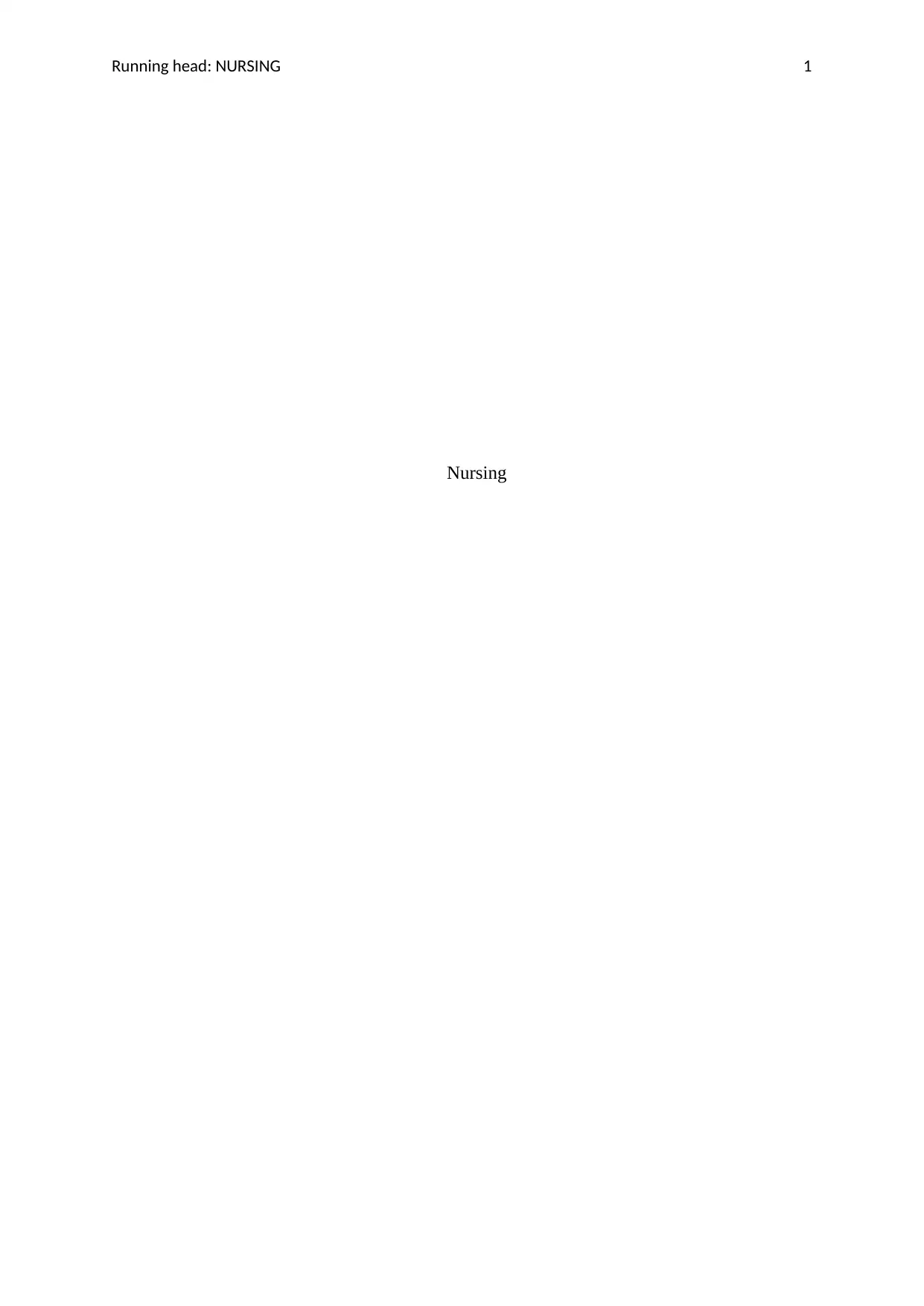
Running head: NURSING 1
Nursing
Nursing
Paraphrase This Document
Need a fresh take? Get an instant paraphrase of this document with our AI Paraphraser
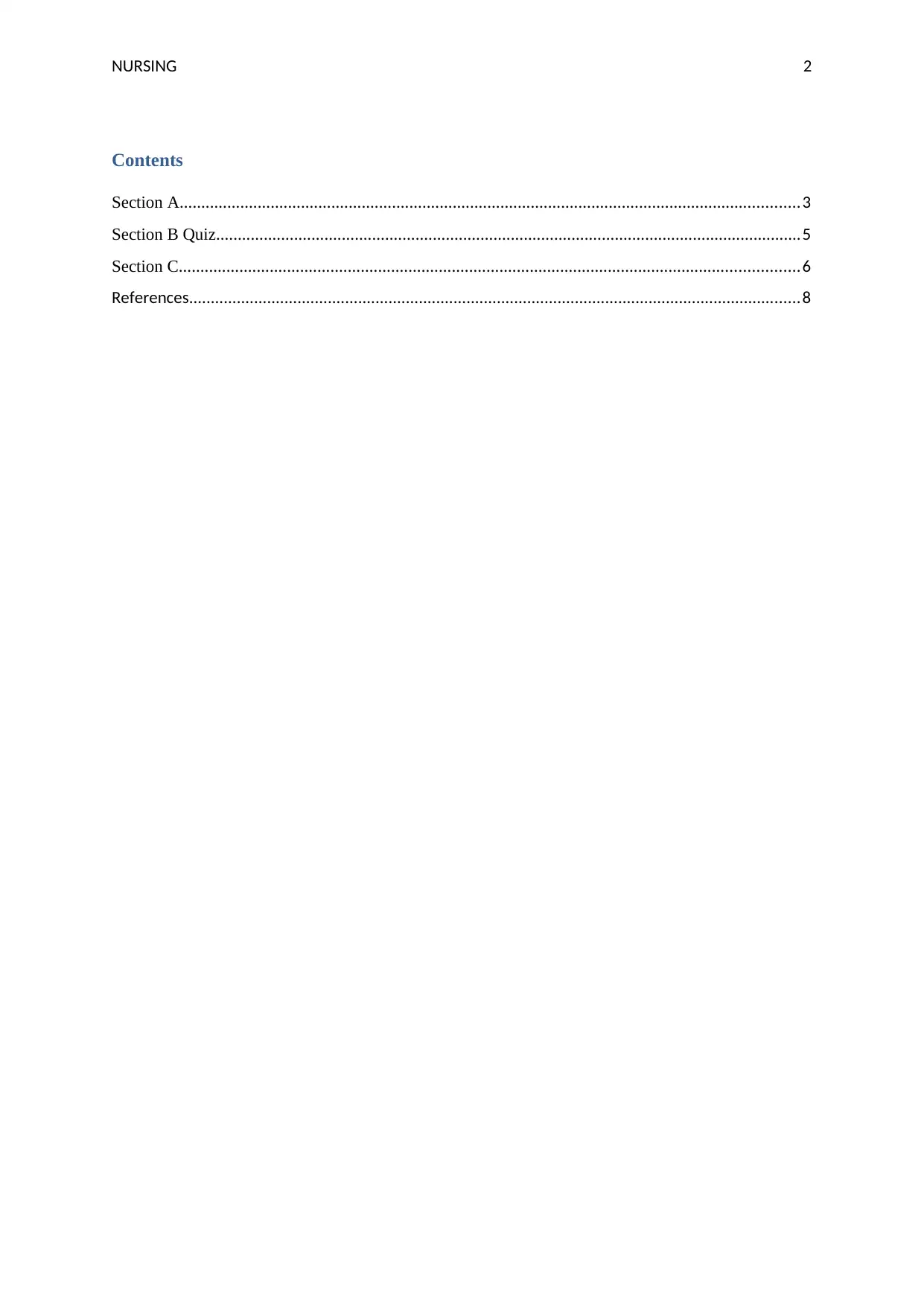
NURSING 2
Contents
Section A...............................................................................................................................................3
Section B Quiz.......................................................................................................................................5
Section C...............................................................................................................................................6
References.............................................................................................................................................8
Contents
Section A...............................................................................................................................................3
Section B Quiz.......................................................................................................................................5
Section C...............................................................................................................................................6
References.............................................................................................................................................8
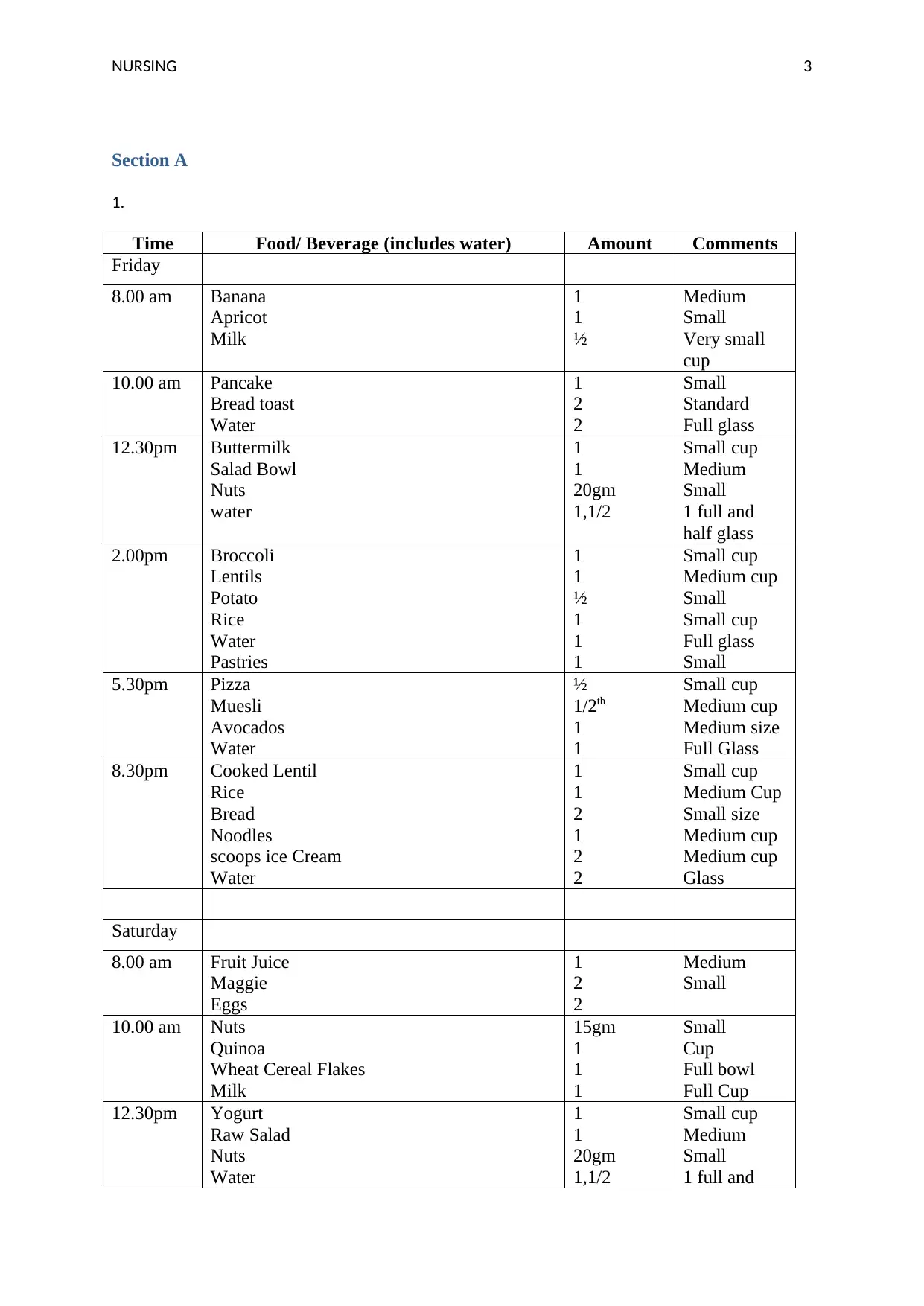
NURSING 3
Section A
1.
Time Food/ Beverage (includes water) Amount Comments
Friday
8.00 am Banana
Apricot
Milk
1
1
½
Medium
Small
Very small
cup
10.00 am Pancake
Bread toast
Water
1
2
2
Small
Standard
Full glass
12.30pm Buttermilk
Salad Bowl
Nuts
water
1
1
20gm
1,1/2
Small cup
Medium
Small
1 full and
half glass
2.00pm Broccoli
Lentils
Potato
Rice
Water
Pastries
1
1
½
1
1
1
Small cup
Medium cup
Small
Small cup
Full glass
Small
5.30pm Pizza
Muesli
Avocados
Water
½
1/2th
1
1
Small cup
Medium cup
Medium size
Full Glass
8.30pm Cooked Lentil
Rice
Bread
Noodles
scoops ice Cream
Water
1
1
2
1
2
2
Small cup
Medium Cup
Small size
Medium cup
Medium cup
Glass
Saturday
8.00 am Fruit Juice
Maggie
Eggs
1
2
2
Medium
Small
10.00 am Nuts
Quinoa
Wheat Cereal Flakes
Milk
15gm
1
1
1
Small
Cup
Full bowl
Full Cup
12.30pm Yogurt
Raw Salad
Nuts
Water
1
1
20gm
1,1/2
Small cup
Medium
Small
1 full and
Section A
1.
Time Food/ Beverage (includes water) Amount Comments
Friday
8.00 am Banana
Apricot
Milk
1
1
½
Medium
Small
Very small
cup
10.00 am Pancake
Bread toast
Water
1
2
2
Small
Standard
Full glass
12.30pm Buttermilk
Salad Bowl
Nuts
water
1
1
20gm
1,1/2
Small cup
Medium
Small
1 full and
half glass
2.00pm Broccoli
Lentils
Potato
Rice
Water
Pastries
1
1
½
1
1
1
Small cup
Medium cup
Small
Small cup
Full glass
Small
5.30pm Pizza
Muesli
Avocados
Water
½
1/2th
1
1
Small cup
Medium cup
Medium size
Full Glass
8.30pm Cooked Lentil
Rice
Bread
Noodles
scoops ice Cream
Water
1
1
2
1
2
2
Small cup
Medium Cup
Small size
Medium cup
Medium cup
Glass
Saturday
8.00 am Fruit Juice
Maggie
Eggs
1
2
2
Medium
Small
10.00 am Nuts
Quinoa
Wheat Cereal Flakes
Milk
15gm
1
1
1
Small
Cup
Full bowl
Full Cup
12.30pm Yogurt
Raw Salad
Nuts
Water
1
1
20gm
1,1/2
Small cup
Medium
Small
1 full and
⊘ This is a preview!⊘
Do you want full access?
Subscribe today to unlock all pages.

Trusted by 1+ million students worldwide
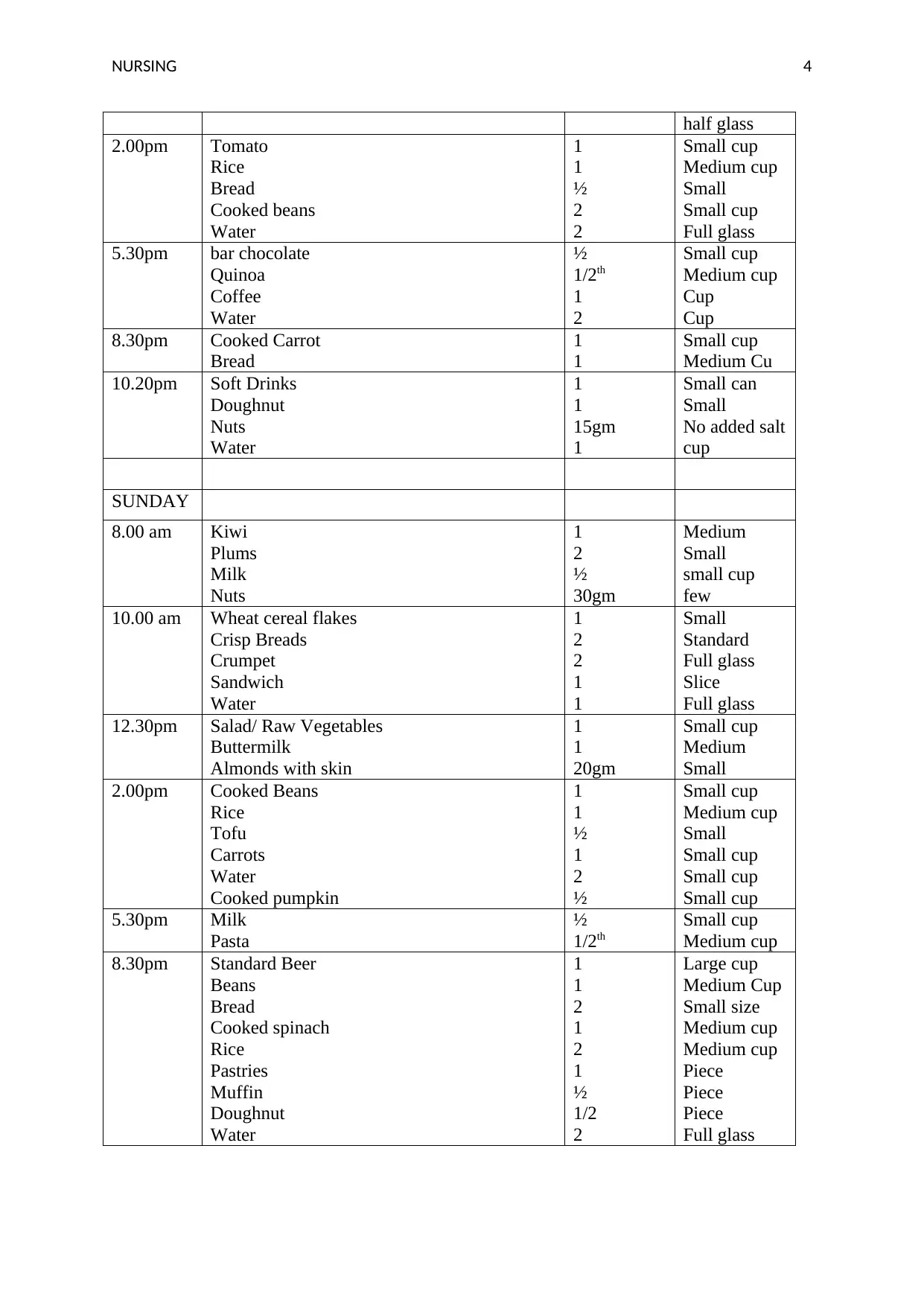
NURSING 4
half glass
2.00pm Tomato
Rice
Bread
Cooked beans
Water
1
1
½
2
2
Small cup
Medium cup
Small
Small cup
Full glass
5.30pm bar chocolate
Quinoa
Coffee
Water
½
1/2th
1
2
Small cup
Medium cup
Cup
Cup
8.30pm Cooked Carrot
Bread
1
1
Small cup
Medium Cu
10.20pm Soft Drinks
Doughnut
Nuts
Water
1
1
15gm
1
Small can
Small
No added salt
cup
SUNDAY
8.00 am Kiwi
Plums
Milk
Nuts
1
2
½
30gm
Medium
Small
small cup
few
10.00 am Wheat cereal flakes
Crisp Breads
Crumpet
Sandwich
Water
1
2
2
1
1
Small
Standard
Full glass
Slice
Full glass
12.30pm Salad/ Raw Vegetables
Buttermilk
Almonds with skin
1
1
20gm
Small cup
Medium
Small
2.00pm Cooked Beans
Rice
Tofu
Carrots
Water
Cooked pumpkin
1
1
½
1
2
½
Small cup
Medium cup
Small
Small cup
Small cup
Small cup
5.30pm Milk
Pasta
½
1/2th
Small cup
Medium cup
8.30pm Standard Beer
Beans
Bread
Cooked spinach
Rice
Pastries
Muffin
Doughnut
Water
1
1
2
1
2
1
½
1/2
2
Large cup
Medium Cup
Small size
Medium cup
Medium cup
Piece
Piece
Piece
Full glass
half glass
2.00pm Tomato
Rice
Bread
Cooked beans
Water
1
1
½
2
2
Small cup
Medium cup
Small
Small cup
Full glass
5.30pm bar chocolate
Quinoa
Coffee
Water
½
1/2th
1
2
Small cup
Medium cup
Cup
Cup
8.30pm Cooked Carrot
Bread
1
1
Small cup
Medium Cu
10.20pm Soft Drinks
Doughnut
Nuts
Water
1
1
15gm
1
Small can
Small
No added salt
cup
SUNDAY
8.00 am Kiwi
Plums
Milk
Nuts
1
2
½
30gm
Medium
Small
small cup
few
10.00 am Wheat cereal flakes
Crisp Breads
Crumpet
Sandwich
Water
1
2
2
1
1
Small
Standard
Full glass
Slice
Full glass
12.30pm Salad/ Raw Vegetables
Buttermilk
Almonds with skin
1
1
20gm
Small cup
Medium
Small
2.00pm Cooked Beans
Rice
Tofu
Carrots
Water
Cooked pumpkin
1
1
½
1
2
½
Small cup
Medium cup
Small
Small cup
Small cup
Small cup
5.30pm Milk
Pasta
½
1/2th
Small cup
Medium cup
8.30pm Standard Beer
Beans
Bread
Cooked spinach
Rice
Pastries
Muffin
Doughnut
Water
1
1
2
1
2
1
½
1/2
2
Large cup
Medium Cup
Small size
Medium cup
Medium cup
Piece
Piece
Piece
Full glass
Paraphrase This Document
Need a fresh take? Get an instant paraphrase of this document with our AI Paraphraser
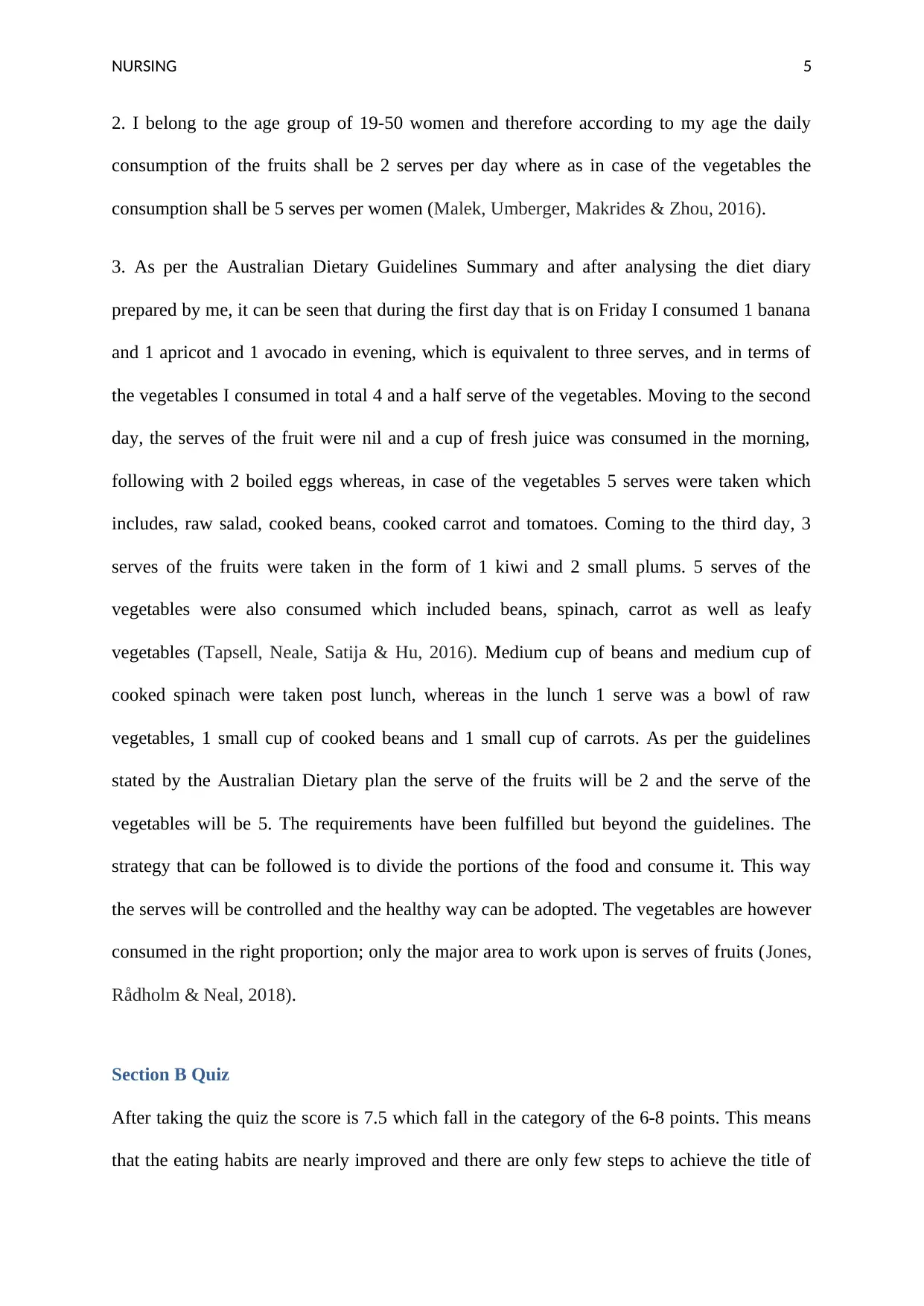
NURSING 5
2. I belong to the age group of 19-50 women and therefore according to my age the daily
consumption of the fruits shall be 2 serves per day where as in case of the vegetables the
consumption shall be 5 serves per women (Malek, Umberger, Makrides & Zhou, 2016).
3. As per the Australian Dietary Guidelines Summary and after analysing the diet diary
prepared by me, it can be seen that during the first day that is on Friday I consumed 1 banana
and 1 apricot and 1 avocado in evening, which is equivalent to three serves, and in terms of
the vegetables I consumed in total 4 and a half serve of the vegetables. Moving to the second
day, the serves of the fruit were nil and a cup of fresh juice was consumed in the morning,
following with 2 boiled eggs whereas, in case of the vegetables 5 serves were taken which
includes, raw salad, cooked beans, cooked carrot and tomatoes. Coming to the third day, 3
serves of the fruits were taken in the form of 1 kiwi and 2 small plums. 5 serves of the
vegetables were also consumed which included beans, spinach, carrot as well as leafy
vegetables (Tapsell, Neale, Satija & Hu, 2016). Medium cup of beans and medium cup of
cooked spinach were taken post lunch, whereas in the lunch 1 serve was a bowl of raw
vegetables, 1 small cup of cooked beans and 1 small cup of carrots. As per the guidelines
stated by the Australian Dietary plan the serve of the fruits will be 2 and the serve of the
vegetables will be 5. The requirements have been fulfilled but beyond the guidelines. The
strategy that can be followed is to divide the portions of the food and consume it. This way
the serves will be controlled and the healthy way can be adopted. The vegetables are however
consumed in the right proportion; only the major area to work upon is serves of fruits (Jones,
Rådholm & Neal, 2018).
Section B Quiz
After taking the quiz the score is 7.5 which fall in the category of the 6-8 points. This means
that the eating habits are nearly improved and there are only few steps to achieve the title of
2. I belong to the age group of 19-50 women and therefore according to my age the daily
consumption of the fruits shall be 2 serves per day where as in case of the vegetables the
consumption shall be 5 serves per women (Malek, Umberger, Makrides & Zhou, 2016).
3. As per the Australian Dietary Guidelines Summary and after analysing the diet diary
prepared by me, it can be seen that during the first day that is on Friday I consumed 1 banana
and 1 apricot and 1 avocado in evening, which is equivalent to three serves, and in terms of
the vegetables I consumed in total 4 and a half serve of the vegetables. Moving to the second
day, the serves of the fruit were nil and a cup of fresh juice was consumed in the morning,
following with 2 boiled eggs whereas, in case of the vegetables 5 serves were taken which
includes, raw salad, cooked beans, cooked carrot and tomatoes. Coming to the third day, 3
serves of the fruits were taken in the form of 1 kiwi and 2 small plums. 5 serves of the
vegetables were also consumed which included beans, spinach, carrot as well as leafy
vegetables (Tapsell, Neale, Satija & Hu, 2016). Medium cup of beans and medium cup of
cooked spinach were taken post lunch, whereas in the lunch 1 serve was a bowl of raw
vegetables, 1 small cup of cooked beans and 1 small cup of carrots. As per the guidelines
stated by the Australian Dietary plan the serve of the fruits will be 2 and the serve of the
vegetables will be 5. The requirements have been fulfilled but beyond the guidelines. The
strategy that can be followed is to divide the portions of the food and consume it. This way
the serves will be controlled and the healthy way can be adopted. The vegetables are however
consumed in the right proportion; only the major area to work upon is serves of fruits (Jones,
Rådholm & Neal, 2018).
Section B Quiz
After taking the quiz the score is 7.5 which fall in the category of the 6-8 points. This means
that the eating habits are nearly improved and there are only few steps to achieve the title of
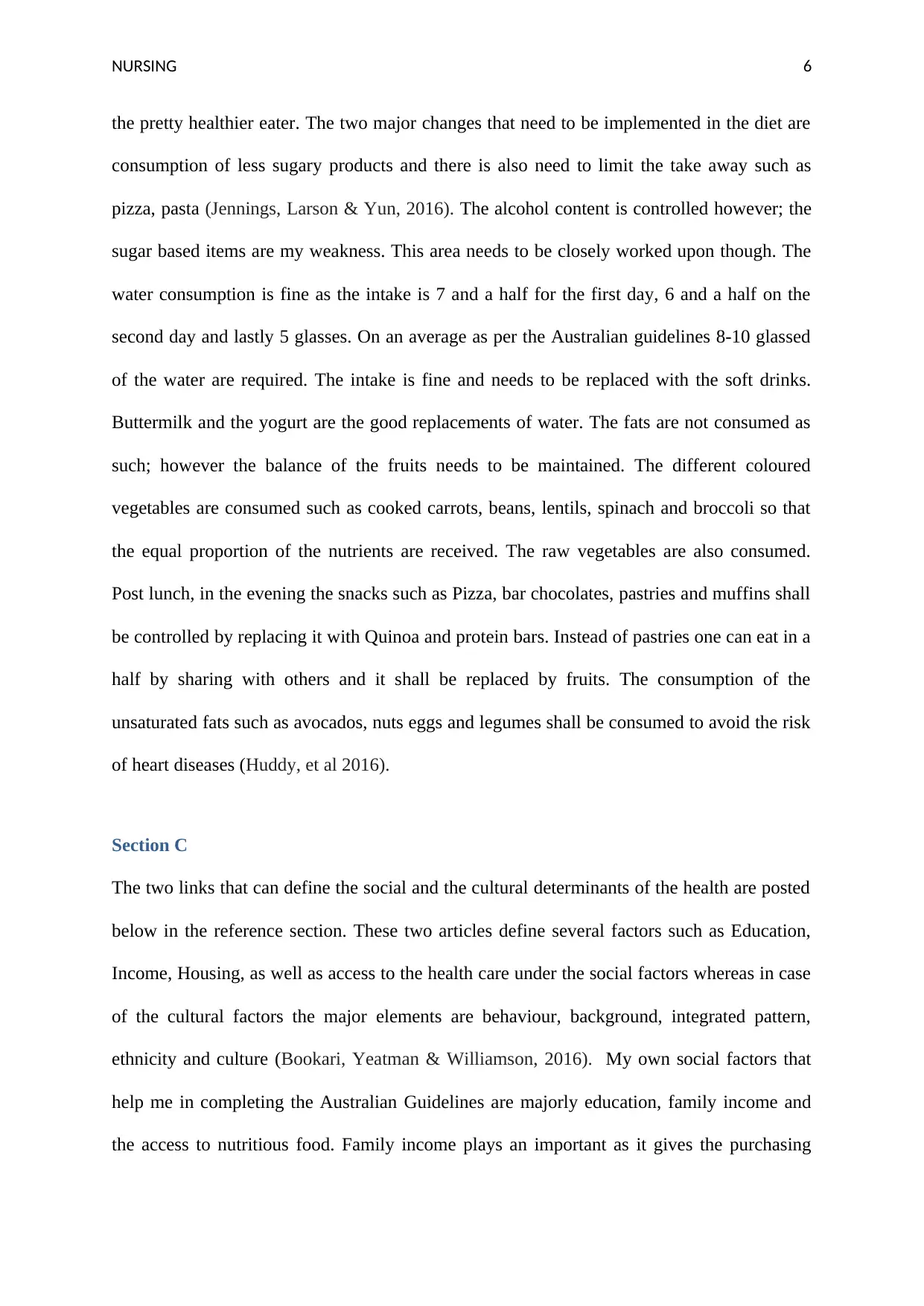
NURSING 6
the pretty healthier eater. The two major changes that need to be implemented in the diet are
consumption of less sugary products and there is also need to limit the take away such as
pizza, pasta (Jennings, Larson & Yun, 2016). The alcohol content is controlled however; the
sugar based items are my weakness. This area needs to be closely worked upon though. The
water consumption is fine as the intake is 7 and a half for the first day, 6 and a half on the
second day and lastly 5 glasses. On an average as per the Australian guidelines 8-10 glassed
of the water are required. The intake is fine and needs to be replaced with the soft drinks.
Buttermilk and the yogurt are the good replacements of water. The fats are not consumed as
such; however the balance of the fruits needs to be maintained. The different coloured
vegetables are consumed such as cooked carrots, beans, lentils, spinach and broccoli so that
the equal proportion of the nutrients are received. The raw vegetables are also consumed.
Post lunch, in the evening the snacks such as Pizza, bar chocolates, pastries and muffins shall
be controlled by replacing it with Quinoa and protein bars. Instead of pastries one can eat in a
half by sharing with others and it shall be replaced by fruits. The consumption of the
unsaturated fats such as avocados, nuts eggs and legumes shall be consumed to avoid the risk
of heart diseases (Huddy, et al 2016).
Section C
The two links that can define the social and the cultural determinants of the health are posted
below in the reference section. These two articles define several factors such as Education,
Income, Housing, as well as access to the health care under the social factors whereas in case
of the cultural factors the major elements are behaviour, background, integrated pattern,
ethnicity and culture (Bookari, Yeatman & Williamson, 2016). My own social factors that
help me in completing the Australian Guidelines are majorly education, family income and
the access to nutritious food. Family income plays an important as it gives the purchasing
the pretty healthier eater. The two major changes that need to be implemented in the diet are
consumption of less sugary products and there is also need to limit the take away such as
pizza, pasta (Jennings, Larson & Yun, 2016). The alcohol content is controlled however; the
sugar based items are my weakness. This area needs to be closely worked upon though. The
water consumption is fine as the intake is 7 and a half for the first day, 6 and a half on the
second day and lastly 5 glasses. On an average as per the Australian guidelines 8-10 glassed
of the water are required. The intake is fine and needs to be replaced with the soft drinks.
Buttermilk and the yogurt are the good replacements of water. The fats are not consumed as
such; however the balance of the fruits needs to be maintained. The different coloured
vegetables are consumed such as cooked carrots, beans, lentils, spinach and broccoli so that
the equal proportion of the nutrients are received. The raw vegetables are also consumed.
Post lunch, in the evening the snacks such as Pizza, bar chocolates, pastries and muffins shall
be controlled by replacing it with Quinoa and protein bars. Instead of pastries one can eat in a
half by sharing with others and it shall be replaced by fruits. The consumption of the
unsaturated fats such as avocados, nuts eggs and legumes shall be consumed to avoid the risk
of heart diseases (Huddy, et al 2016).
Section C
The two links that can define the social and the cultural determinants of the health are posted
below in the reference section. These two articles define several factors such as Education,
Income, Housing, as well as access to the health care under the social factors whereas in case
of the cultural factors the major elements are behaviour, background, integrated pattern,
ethnicity and culture (Bookari, Yeatman & Williamson, 2016). My own social factors that
help me in completing the Australian Guidelines are majorly education, family income and
the access to nutritious food. Family income plays an important as it gives the purchasing
⊘ This is a preview!⊘
Do you want full access?
Subscribe today to unlock all pages.

Trusted by 1+ million students worldwide
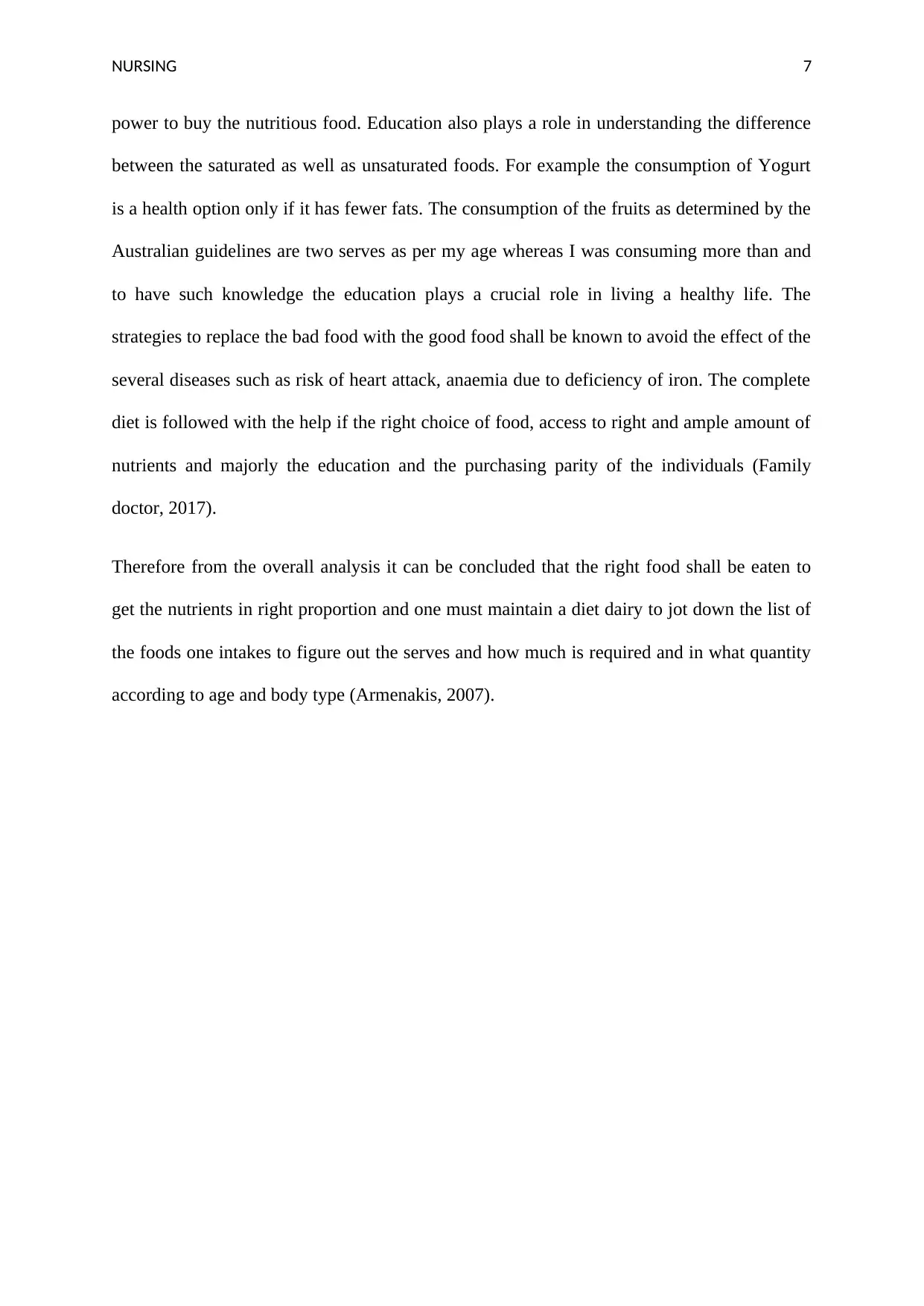
NURSING 7
power to buy the nutritious food. Education also plays a role in understanding the difference
between the saturated as well as unsaturated foods. For example the consumption of Yogurt
is a health option only if it has fewer fats. The consumption of the fruits as determined by the
Australian guidelines are two serves as per my age whereas I was consuming more than and
to have such knowledge the education plays a crucial role in living a healthy life. The
strategies to replace the bad food with the good food shall be known to avoid the effect of the
several diseases such as risk of heart attack, anaemia due to deficiency of iron. The complete
diet is followed with the help if the right choice of food, access to right and ample amount of
nutrients and majorly the education and the purchasing parity of the individuals (Family
doctor, 2017).
Therefore from the overall analysis it can be concluded that the right food shall be eaten to
get the nutrients in right proportion and one must maintain a diet dairy to jot down the list of
the foods one intakes to figure out the serves and how much is required and in what quantity
according to age and body type (Armenakis, 2007).
power to buy the nutritious food. Education also plays a role in understanding the difference
between the saturated as well as unsaturated foods. For example the consumption of Yogurt
is a health option only if it has fewer fats. The consumption of the fruits as determined by the
Australian guidelines are two serves as per my age whereas I was consuming more than and
to have such knowledge the education plays a crucial role in living a healthy life. The
strategies to replace the bad food with the good food shall be known to avoid the effect of the
several diseases such as risk of heart attack, anaemia due to deficiency of iron. The complete
diet is followed with the help if the right choice of food, access to right and ample amount of
nutrients and majorly the education and the purchasing parity of the individuals (Family
doctor, 2017).
Therefore from the overall analysis it can be concluded that the right food shall be eaten to
get the nutrients in right proportion and one must maintain a diet dairy to jot down the list of
the foods one intakes to figure out the serves and how much is required and in what quantity
according to age and body type (Armenakis, 2007).
Paraphrase This Document
Need a fresh take? Get an instant paraphrase of this document with our AI Paraphraser
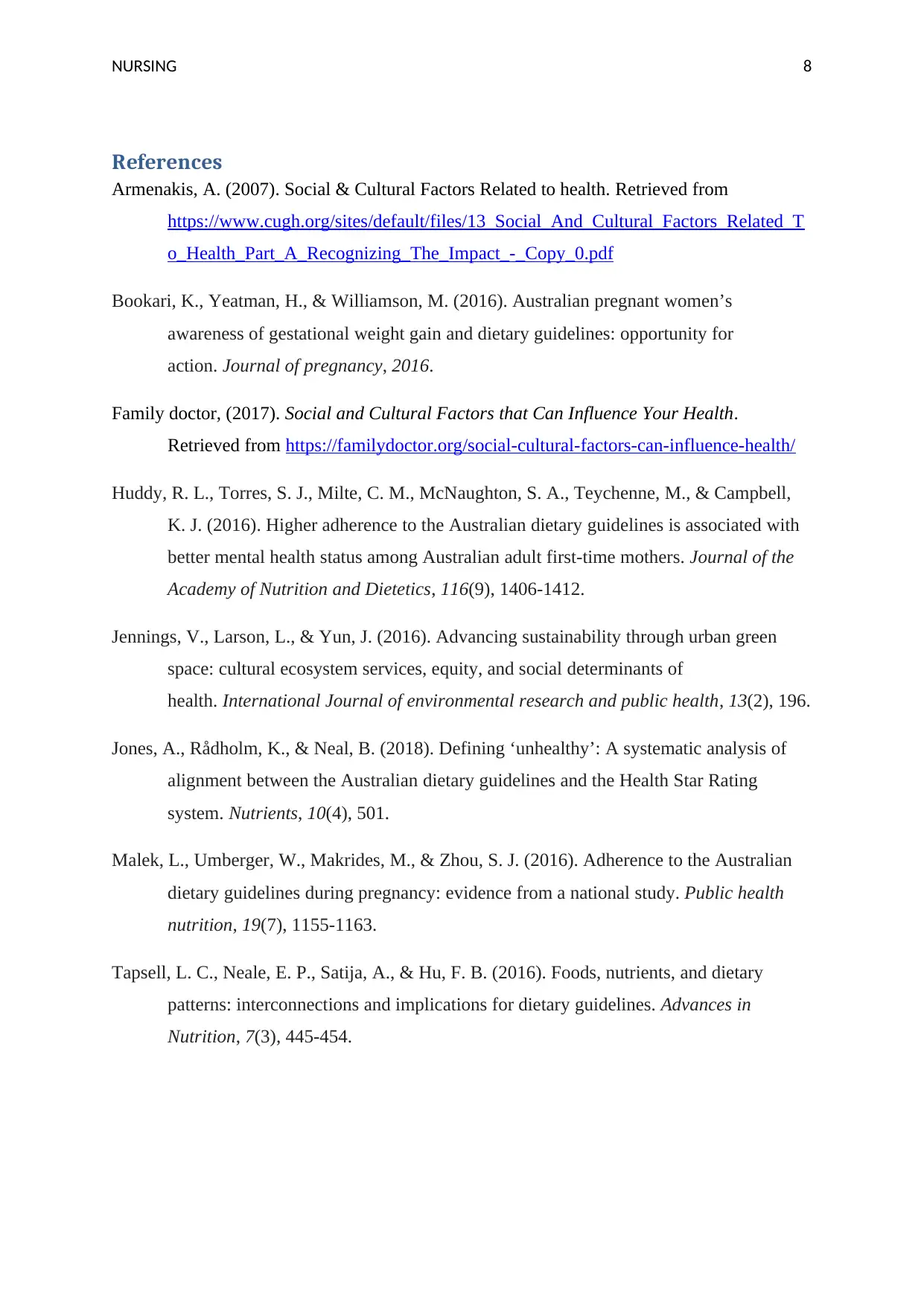
NURSING 8
References
Armenakis, A. (2007). Social & Cultural Factors Related to health. Retrieved from
https://www.cugh.org/sites/default/files/13_Social_And_Cultural_Factors_Related_T
o_Health_Part_A_Recognizing_The_Impact_-_Copy_0.pdf
Bookari, K., Yeatman, H., & Williamson, M. (2016). Australian pregnant women’s
awareness of gestational weight gain and dietary guidelines: opportunity for
action. Journal of pregnancy, 2016.
Family doctor, (2017). Social and Cultural Factors that Can Influence Your Health.
Retrieved from https://familydoctor.org/social-cultural-factors-can-influence-health/
Huddy, R. L., Torres, S. J., Milte, C. M., McNaughton, S. A., Teychenne, M., & Campbell,
K. J. (2016). Higher adherence to the Australian dietary guidelines is associated with
better mental health status among Australian adult first-time mothers. Journal of the
Academy of Nutrition and Dietetics, 116(9), 1406-1412.
Jennings, V., Larson, L., & Yun, J. (2016). Advancing sustainability through urban green
space: cultural ecosystem services, equity, and social determinants of
health. International Journal of environmental research and public health, 13(2), 196.
Jones, A., Rådholm, K., & Neal, B. (2018). Defining ‘unhealthy’: A systematic analysis of
alignment between the Australian dietary guidelines and the Health Star Rating
system. Nutrients, 10(4), 501.
Malek, L., Umberger, W., Makrides, M., & Zhou, S. J. (2016). Adherence to the Australian
dietary guidelines during pregnancy: evidence from a national study. Public health
nutrition, 19(7), 1155-1163.
Tapsell, L. C., Neale, E. P., Satija, A., & Hu, F. B. (2016). Foods, nutrients, and dietary
patterns: interconnections and implications for dietary guidelines. Advances in
Nutrition, 7(3), 445-454.
References
Armenakis, A. (2007). Social & Cultural Factors Related to health. Retrieved from
https://www.cugh.org/sites/default/files/13_Social_And_Cultural_Factors_Related_T
o_Health_Part_A_Recognizing_The_Impact_-_Copy_0.pdf
Bookari, K., Yeatman, H., & Williamson, M. (2016). Australian pregnant women’s
awareness of gestational weight gain and dietary guidelines: opportunity for
action. Journal of pregnancy, 2016.
Family doctor, (2017). Social and Cultural Factors that Can Influence Your Health.
Retrieved from https://familydoctor.org/social-cultural-factors-can-influence-health/
Huddy, R. L., Torres, S. J., Milte, C. M., McNaughton, S. A., Teychenne, M., & Campbell,
K. J. (2016). Higher adherence to the Australian dietary guidelines is associated with
better mental health status among Australian adult first-time mothers. Journal of the
Academy of Nutrition and Dietetics, 116(9), 1406-1412.
Jennings, V., Larson, L., & Yun, J. (2016). Advancing sustainability through urban green
space: cultural ecosystem services, equity, and social determinants of
health. International Journal of environmental research and public health, 13(2), 196.
Jones, A., Rådholm, K., & Neal, B. (2018). Defining ‘unhealthy’: A systematic analysis of
alignment between the Australian dietary guidelines and the Health Star Rating
system. Nutrients, 10(4), 501.
Malek, L., Umberger, W., Makrides, M., & Zhou, S. J. (2016). Adherence to the Australian
dietary guidelines during pregnancy: evidence from a national study. Public health
nutrition, 19(7), 1155-1163.
Tapsell, L. C., Neale, E. P., Satija, A., & Hu, F. B. (2016). Foods, nutrients, and dietary
patterns: interconnections and implications for dietary guidelines. Advances in
Nutrition, 7(3), 445-454.
1 out of 8
Related Documents
Your All-in-One AI-Powered Toolkit for Academic Success.
+13062052269
info@desklib.com
Available 24*7 on WhatsApp / Email
![[object Object]](/_next/static/media/star-bottom.7253800d.svg)
Unlock your academic potential
Copyright © 2020–2025 A2Z Services. All Rights Reserved. Developed and managed by ZUCOL.




